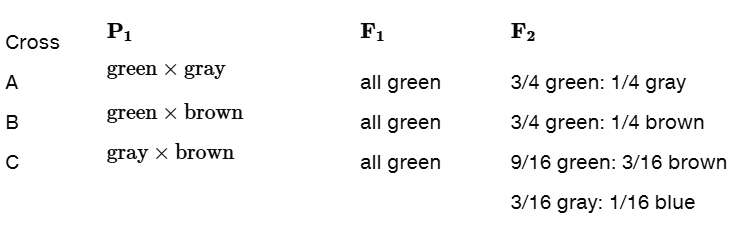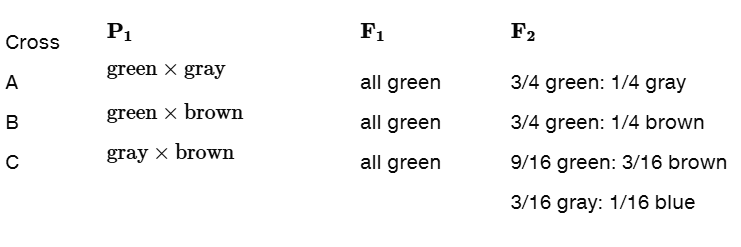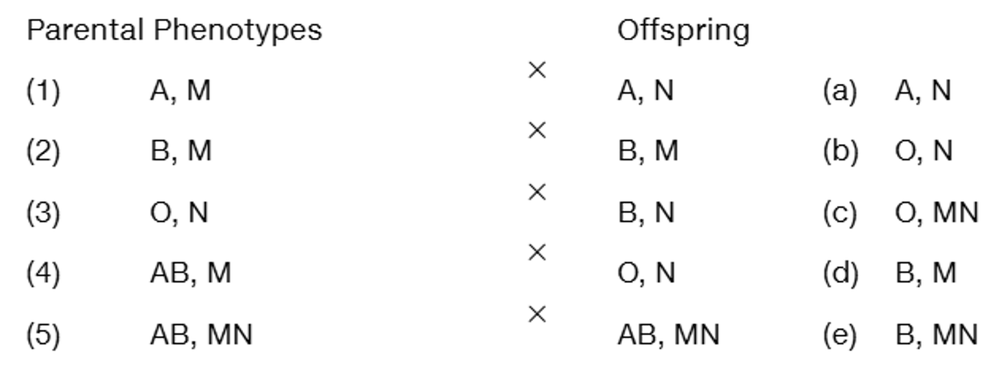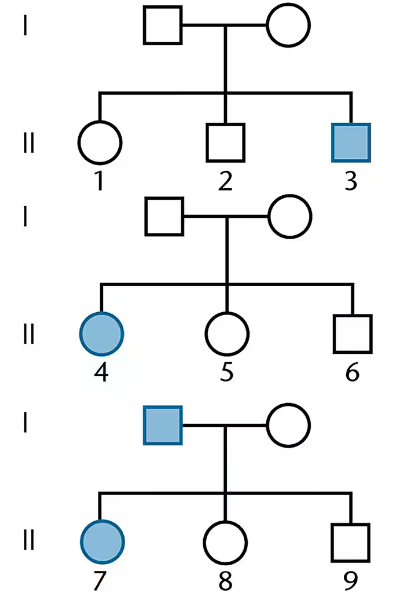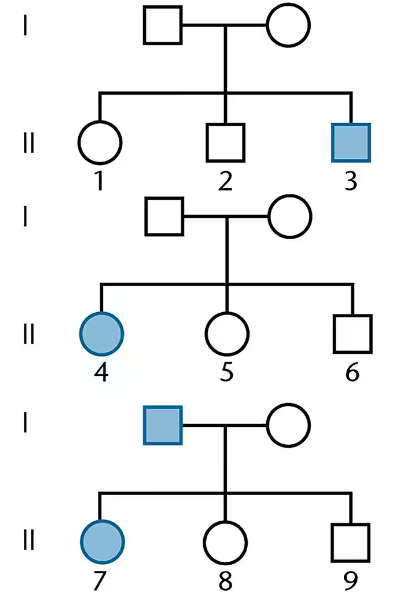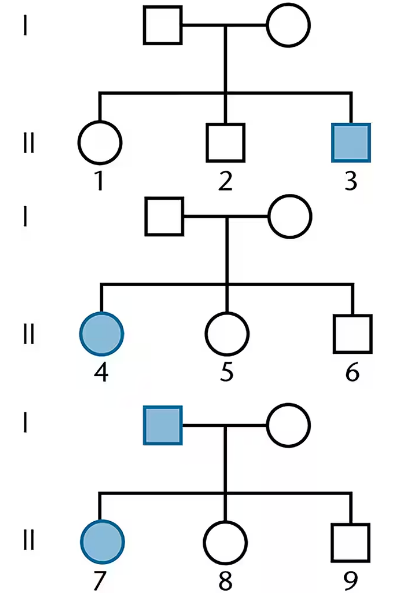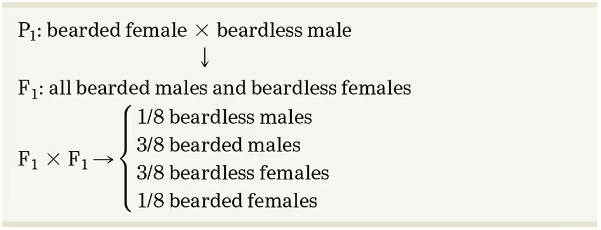 Back
BackProblem 18c
Given the inheritance pattern of coat color in rats described in Problem 17, predict the genotype and phenotype of the parents who produced the following offspring: 27/64 gray:
16/64 albino: 9/64 yellow: 9/64 black: 3/64 cream
Problem 18d
Given the inheritance pattern of coat color in rats described in Problem 17, predict the genotype and phenotype of the parents who produced the following offspring:
3/8 black: 3/8 cream: 2/8 albino
Problem 18e
Given the inheritance pattern of coat color in rats described in Problem 17, predict the genotype and phenotype of the parents who produced the following offspring:
3/8 black: 4/8 albino: 1/8 cream
Problem 19a
In a species of the cat family, eye color can be gray, blue, green, or brown, and each trait is true breeding. In separate crosses involving homozygous parents, the following data were obtained:
How many genes are involved? Define gene symbols and indicate which genotypes yield each phenotype.
Problem 19b
In a species of the cat family, eye color can be gray, blue, green, or brown, and each trait is true breeding. In separate crosses involving homozygous parents, the following data were obtained:
In a cross between a gray-eyed cat and one of unknown genotype and phenotype, the F₁ generation was not observed. However, the F₂ resulted in the same F₂ ratio as in cross C. Determine the genotypes and phenotypes of the unknown P₁ and F₁ cats.
Problem 20a
In a plant, a tall variety was crossed with a dwarf variety. All F₁ plants were tall. When F₁xF₁ plants were interbred, 9/16 of the F₂ were tall and 7/16 were dwarf. Explain the inheritance of height by indicating the number of gene pairs involved and by designating which genotypes yield tall and which yield dwarf. (Use dashes where appropriate.)
Problem 20b
In a plant, a tall variety was crossed with a dwarf variety. All F₁ plants were tall. When F₁xF₁ plants were interbred, 9/16 of the F₂ were tall and 7/16 were dwarf. What proportion of the F₂ plants will be true breeding if self-fertilized? List these genotypes.
Problem 21a
In a unique species of plants, flowers may be yellow, blue, red, or mauve. All colors may be true breeding. If plants with blue flowers are crossed with red-flowered plants, all F₁ plants have yellow flowers. When these produced an F₂ generation, the following ratio was observed:
9/16 yellow: 3/16 blue: 3/16 red: 1/16 mauve
In still another cross using true-breeding parents, yellow-flowered plants are crossed with mauve-flowered plants. Again, all F₁ plants had yellow flowers, and the F₂ showed a 9:3:3:1 ratio, as just shown.
Describe the inheritance of flower color by defining gene symbols and designating which genotypes give rise to each of the four phenotypes.
Problem 21b
In a unique species of plants, flowers may be yellow, blue, red, or mauve. All colors may be true breeding. If plants with blue flowers are crossed with red-flowered plants, all F₁ plants have yellow flowers. When these produced an F₂ generation, the following ratio was observed:
9/16 yellow: 3/16 blue: 3/16 red: 1/16 mauve
In still another cross using true-breeding parents, yellow-flowered plants are crossed with mauve-flowered plants. Again, all F₁ plants had yellow flowers, and the F₂ showed a 9:3:3:1 ratio, as just shown. Determine the F₁ and F₂ results of a cross between true-breeding red and true-breeding mauve-flowered plants.
Problem 22
Five human matings (1–5), identified by both maternal and paternal phenotypes for ABO and MN blood-group antigen status, are shown on the left side of the following table:
Each mating resulted in one of the five offspring shown in the right-hand column (a–e). Match each offspring with one correct set of parents, using each parental set only once. Is there more than one set of correct answers?
Problem 23
A husband and wife have normal vision, although both of their fathers are red–green color-blind, an inherited X-linked recessive condition. What is the probability that their first child will be (a) a normal son, (b) a normal daughter, (c) a color-blind son, (d) a color-blind daughter?
Problem 24
In humans, the ABO blood type is under the control of autosomal multiple alleles. Color blindness is a recessive X-linked trait. If two parents who are both type A and have normal vision produce a son who is color-blind and is type O, what is the probability that their next child will be a female who has normal vision and is type O?
Problem 25
In Drosophila, an X-linked recessive mutation, scalloped (sd), causes irregular wing margins. Diagram the F₁ and F₂ results if (a) a scalloped female is crossed with a normal male; (b) a scalloped male is crossed with a normal female. Compare these results with those that would be obtained if the scalloped gene were autosomal.
Problem 26
Another recessive mutation in Drosophila, ebony (e), is on an autosome (chromosome 3) and causes darkening of the body compared with wild-type flies. What phenotypic F₁ and F₂ male and female ratios will result if a scalloped-winged female with normal body color is crossed with a normal-winged ebony male?
Work out this problem by both the Punnett square method and the forked-line method.
Problem 27
In Drosophila, the X-linked recessive mutation vermilion (v) causes bright red eyes, in contrast to the brick-red eyes of wild type. A separate autosomal recessive mutation, suppressor of vermilion (su-v), causes flies homozygous or hemizygous for v to have wild-type eyes. In the absence of vermilion alleles, su-v has no effect on eye color. Determine the F₁ and F₂ phenotypic ratios from a cross between a female with wild-type alleles at the vermilion locus, but who is homozygous for su-v, with a vermilion male who has wild-type alleles at the su-v locus.
Problem 28a
While vermilion is X-linked in Drosophila and causes the eye color to be bright red, brown is an autosomal recessive mutation that causes the eye to be brown. Flies carrying both mutations lose all pigmentation and are white-eyed. Predict the F₁ and F₂ results of the following crosses:
vermilion females x brown males
Problem 28b
While vermilion is X-linked in Drosophila and causes the eye color to be bright red, brown is an autosomal recessive mutation that causes the eye to be brown. Flies carrying both mutations lose all pigmentation and are white-eyed. Predict the F₁ and F₂ results of the following crosses:
brown females x vermilion males
Problem 28c
While vermilion is X-linked in Drosophila and causes the eye color to be bright red, brown is an autosomal recessive mutation that causes the eye to be brown. Flies carrying both mutations lose all pigmentation and are white-eyed. Predict the F₁ and F₂ results of the following crosses:
white females x wild-type males
Problem 29a
In a cross in Drosophila involving the X-linked recessive eye mutation white and the autosomally linked recessive eye mutation sepia (resulting in a dark eye), predict the F₁ and F₂ results of crossing true-breeding parents of the following phenotypes: Note that white is epistatic to the expression of sepia.
white females x sepia males
Problem 29b
In a cross in Drosophila involving the X-linked recessive eye mutation white and the autosomally linked recessive eye mutation sepia (resulting in a dark eye), predict the F₁ and F₂ results of crossing true-breeding parents of the following phenotypes: Note that white is epistatic to the expression of sepia.
sepia females x white males
Problem 30a
Consider the three pedigrees below, all involving a single human trait.
Which combination of conditions, if any, can be excluded? dominant and X-linked dominant and autosomal recessive and X-linked recessive and autosomal
Problem 30b
Consider the three pedigrees below, all involving a single human trait.
For each combination that you excluded, indicate the single individual in generation II (e.g., II-1, II-2) that was most instrumental in your decision to exclude it. If none were excluded, answer 'none apply.'
Problem 30c
Consider the three pedigrees below, all involving a single human trait.
Given your conclusions in part (a), indicate the genotype of the following individuals: II-1, II-6, II-9 If more than one possibility applies, list all possibilities. Use the symbols A and a for the genotypes.
Problem 31
In goats, the development of the beard is due to a recessive gene. The following cross involving true-breeding goats was made and carried to the F₂ generation:
Offer an explanation for the inheritance and expression of this trait, diagramming the cross. Propose one or more crosses to test your hypothesis.
Problem 32
Predict the F₁ and F₂ results of crossing a male fowl that is cock-feathered with a true-breeding hen-feathered female fowl. Recall that these traits are sex limited.
Problem 33
Two mothers give birth to sons at the same time at a busy urban hospital. The son of mother 1 is afflicted with hemophilia, a disease caused by an X-linked recessive allele. Neither parent has the disease. Mother 2 has a normal son, despite the fact that the father has hemophilia. Several years later, couple 1 sues the hospital, claiming that these two newborns were swapped in the nursery following their birth. As a genetic counselor, you are called to testify. What information can you provide the jury concerning the allegation?
Problem 34
Discuss the topic of phenotypic expression and the many factors that impinge on it.
Problem 35
Contrast penetrance and expressivity as the terms relate to phenotypic expression.
Problem 36
Labrador retrievers may be black, brown (chocolate), or golden (yellow) in color (see chapter-opening photo). While each color may breed true, many different outcomes are seen when numerous litters are examined from a variety of matings where the parents are not necessarily true breeding. Following are just some of the many possibilities.
(a) black x brown → all black
(b) black x brown → 1/2 black, 1/2 brown
(c) black x brown → 3/4 black, 1/4 golden
(d) black x golden → all black
(e) black x golden → 4/8 golden 3/8 black 1/8 brown
(f) black x golden → 2/4 golden 1/4 black 1/4 brown
(g) brown x brown → 3/4 brown 1/4 golden
(h) black x black → 9/16 black 4/16 golden, 3/16 brown
Propose a mode of inheritance that is consistent with these data, and indicate the corresponding genotypes of the parents in each mating. Indicate as well the genotypes of dogs that breed true for each color.
Problem 37
A true-breeding purple-leafed plant isolated from one side of El Yunque, the rain forest in Puerto Rico, was crossed to a true-breeding white variety found on the other side. The F₁ offspring were all purple. A large number of F₁ x F₁ crosses produced the following results:
purple: 4219, white: 5781 (Total = 10,000)
Propose an explanation for the inheritance of leaf color. As a geneticist, how might you go about testing your hypothesis? Describe the genetic experiments that you would conduct.

